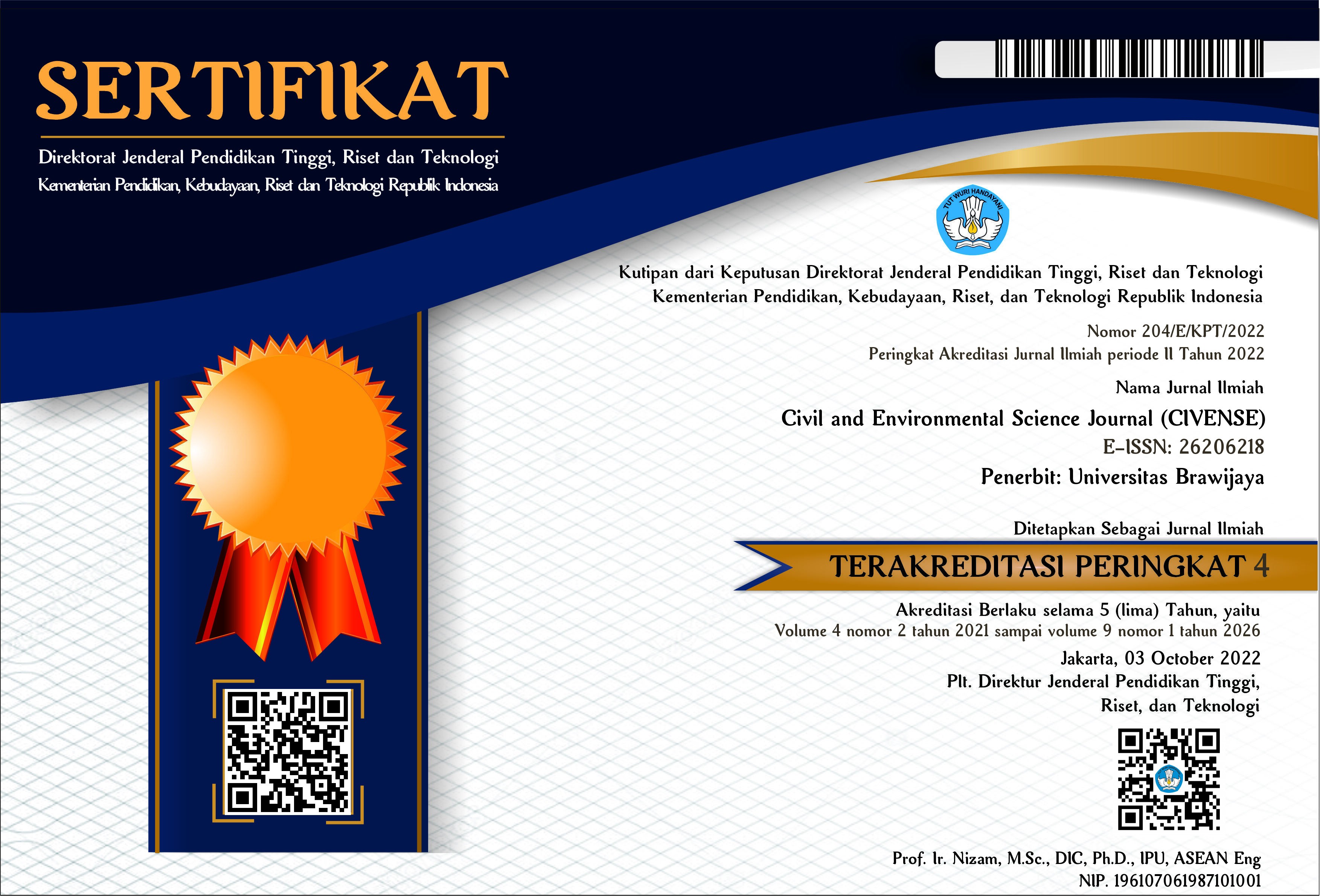Bearing Capacity of Large Drilled Shafts Fully Embeded in Claystone and Sandstone Layers
DOI:
https://doi.org/10.21776/ub.civense.2022.00502.2Keywords:
claystone, sandstone, drilled shaft, bearing capacity, Osterberg cell testAbstract
This paper focuses on analyzing the bearing capacity of large diameter drilled shafts that are fully embedded in the claystone and sandstone layers. The foundations used are the drilled shafts for the Pulau Balang bridge pylons built across the Balikpapan bay. Three bored pile foundations with a planned diameter of 2 meters by 60 meters were used. The bearing capacity of the foundation in the field was carried out using the Osterberg cell test. The bearing capacity of the upper side of the foundation is 32.77, 27.26, and 114.46 MN, and the lower parts are 26.98, 27.16, and 50.25 MN, respectively. The results show that the method closest to the upper part of the OC test is the method suggested by Kulhawy and Phoon, with a value of C = 0.5. As for the lower part, the closest approach is the combination of the Kulhawy and Phoon and the Rowe and Armitage methods. The combinations of methods that approximate the total bearing capacity of the field are the Kulhawy and Phoon (1993) and Rowe and Armitage (1987) methods for the dominant claystone layer, and the O'Neil and Reese (1993) and Rowe and Armitage (1987) methods for the main sandstone layer.
References
A. F. Williams and P. J. N. Pells, “Side Resistance Rock Sockets in Sandstone, Mudstone, and Shale.,” Can. Geotech. J., vol. 18, no. 4, pp. 502–513, 1981, doi: 10.1139/t81-061.
R. K. Rowe and H. H. Armitage, “Design Method for Drilled Piers in Soft Rock.,” Can. Geotech. J., vol. 24, no. 1, pp. 126–142, 1987, doi: 10.1139/t87-011.
L. Zhang and H. H. Einstein, “End bearing capacity of drilled shafts in rock,” J. Geotech. Geoenvironmental Eng., vol. 124, no. 7, pp. 574–584, 1998, doi: 10.1061/(ASCE)1090-0241(1998)124:7(574).
P. Carrubba, “Skin friction on large-diameter piles socketed into rock,” Can. Geotech. J., vol. 34, no. 2, pp. 230–240, 1997, doi: 10.1139/cgj-34-2-230.
M. Irsyam, A. Sahadewa, A. Boesono, and Soebagyo, “Pengaruh Strength Reduction Tanah Clay-Shale akibat Pelaksanaan Pemboran terhadap Nilai Daya Dukung Pondasi Tiang di Jembatan Suramadu Berdasarkan Analisis Hasil Tes OC,” J. Tek. Sipil, vol. 14, no. 2, pp. 69–82, 2007.
M. W. O’Neill, “Side Resistance in Piles and Drilled Shafts,” J. Geotech. Geoenvironmental Eng., vol. 127, pp. 3–16, 2001.
H. C. Chan, “Non-Destructive Testing of Concrete Piles using the Sonic Echo and Transient Shock Methods,” University of Edinburgh, 1987.
A. Z. El Wakil and M. Kassim, “Bulging as a pile imperfection,” Alexandria Eng. J., vol. 49, no. 4, pp. 387–391, 2010, doi: 10.1016/j.aej.2010.07.004.
D. Sibit and G. Handayani, “The Crosshole Sonic Logging (CSL) Measurement System to Measure the Quality of Physical Model of Bored Pile,” J. Phys. Conf. Ser., vol. 739, no. 1, 2016, doi: 10.1088/1742-6596/739/1/012051.
X. Yu, M. Y. Abu-Farsakh, S. Yoon, C. Tsai, and Z. Zhang, “Implementation of LRFD of Drilled Shafts in Louisiana,” J. Infrastruct. Syst., vol. 18, no. 2, pp. 103–112, 2012, doi: 10.1061/(ASCE)IS.1943-555X.0000084.
H. G. Poulos, “Tall building foundations: design methods and applications,” Innov. Infrastruct. Solut., vol. 1, no. 1, pp. 1–51, 2016, doi: 10.1007/s41062-016-0010-2.
ASTM-D1143, “Standard Test Method for Piles Under Static Axial Compressive Load,” Am. Soc. Test. Mater., vol. 4, no. 8, pp. 1–12, 2010.
D. A. Brown, J. P. Turner, and R. J. Castelli, Drilled Shafts: Construction Procedures and LRFD Design Methods, no. FHWA NHI-10-016. New York, 2010.
NCHRP, “Load and Resistance Factor Design (LRFD) for Deep Foundations,” Washington D.C., 2004.
M. W. O’neill and L. C. Reese, Drilled Shafts: Construction Procedures and Design Methods. FHWA-IF-99-025, 1999.
L. Stark T. J., Assem, P, “Improvement for Determining the Axial Capacity of Drilled Shafts in Shale in Illinois,” Illinois, 2013.
M. W. O’neill, F. C. Townsand, K. M. Hassan, A. Buller, and P. S. Chan, Load Transfer for Drilled Shafts in Intermediate Geomaterials. 1996.
A. Alshenawy, W. Hamid, and A. Alnuaim, “Skin friction behavior of pile fully embedded in limestone,” Arab. J. Geosci., vol. 11, no. 2, pp. 1–7, 2018, doi: 10.1007/s12517-018-3386-9.
S. K. Martin and K. Syngros, “Bored Pile Construction Challenges in Highly Variable Limestone for a Supertall Building,” in International Conference on Deep Foundations, Seepage Control and Remediation (41st Annual), 2016.
T. Y. Chin and C. C. Meng, “Foundation Design and Construction in Limestone Formation: A Malaysian Consultant’s Experience,” in International Symposium on Advances in Foundation Engineering (ISAFE 2013), 2013.
E. L. Juvencio, F. R. Lopes, and A. L. L. S. Nunes, “An evaluation of the shaft resistance of piles embedded in gneissic rock,” Soils and Rocks, vol. 40, no. 1, pp. 61–74, 2017.
A. Alshenawy, W. Hamid, and A. Alnuaim, “Skin friction behavior of pile fully embedded in limestone,” Arab. J. Geosci., vol. 11, no. 2, pp. 1–7, 2018, doi: 10.1007/s12517-018-3386-9.
S. Rezazadeh and A. Eslami, “Empirical methods for determining shaft bearing capacity of semi-deep foundations socketed in rocks,” J. Rock Mech. Geotech. Eng., vol. 9, no. 6, pp. 1140–1151, 2017, doi: 10.1016/j.jrmge.2017.06.003.
L. Zhang, Drilled Shafts in Rock: Analysis and Design. Leiden: A.A.Balkema Publishers, 2004.
L. Zhang, “Determination and applications of rock quality designation (RQD),” J. Rock Mech. Geotech. Eng., vol. 8, no. 3, pp. 389–397, 2016, doi: 10.1016/j.jrmge.2015.11.008.
SNI8460, “Standar Nasional Perancangan Geoteknik,” Badan Stand. Nas. Indones., pp. 1–323, 2017.
Downloads
Published
How to Cite
Issue
Section
License
Copyright (c) 2022 Yulian Firmana Arifin, Muhammad An Al Marwaji

This work is licensed under a Creative Commons Attribution-NonCommercial 4.0 International License.
Authors who publish with this journal agree to the following terms:
Authors retain copyright and grant the journal right of first publication with the work simultaneously licensed under a Attribution-NonCommercial 4.0 International License that allows others to share the work with an acknowledgement of the work's authorship and initial publication in this journal.
Authors are able to enter into separate, additional contractual arrangements for the non-exclusive distribution of the journal's published version of the work (e.g., post it to an institutional repository or publish it in a book), with an acknowledgement of its initial publication in this journal.
Authors are permitted and encouraged to post their work online (e.g., in institutional repositories or on their website) prior to and during the submission process, as it can lead to productive exchanges, as well as earlier and greater citation of published work (See the Effect of Open Access).














